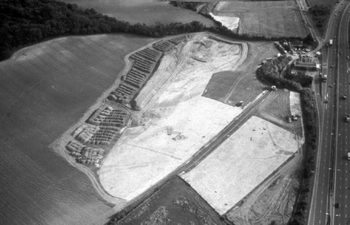White Horse Stone, Aylesford, Kent - Integrated Site Report
Oxford Archaeology (South), 2009. (updated 2017) https://doi.org/10.5284/1044807. How to cite using this DOI
Data copyright © High Speed 1 unless otherwise stated
This work is licensed under the ADS Terms of Use and Access.
Primary contact
Stuart
Foreman
Senior Project Manager
Oxford Archaeology (South)
Janus House
Osney Mead
Oxford
OX2 0ES
UK
Tel: 01865 263800
Fax: 01865 793496
Resource identifiers
- ADS Collection: 2434
- DOI:https://doi.org/10.5284/1044807
- How to cite using this DOI
Introduction

As part of an extensive programme of archaeological investigations carried out in advance of the construction of the Channel Tunnel Rail Link (CTRL), Oxford Archaeology (formerly Oxford Archaeological Unit) was commissioned to undertake archaeological excavations at the White Horse Stone, Pilgrim's Way, and West of Boarley Farm, on the boundary between Boxley and Aylesford parishes, in Kent. The investigations were carried out between October 1998 and March 1999, under the project management of Rail Link Engineering, on behalf of Union Railways (South) Limited (a subsidiary of London and Continental Railways).
The remains of two early Neolithic, post-built, rectangular structures were found sealed below an Iron Age plough soil. Both were associated with very small assemblages of fragmented finds, including small Plain Bowl sherds, flint, animal bone, charred plant remains and charcoal. Radiocarbon dates suggest they date from 4110-3530 cal BC. Although some of the postholes associated with these structures cut tree-throw holes, there is little evidence for any preceding activity. Residual Decorated Bowl sherds suggest activity slightly later in the early Neolithic. Middle Neolithic activity is evidenced by finds of Mortlake-style Peterborough Ware from two small groups of shallow pits near to one of the early Neolithic structures. Two small, round, post- and stake-built structures probably date from the late Neolithic. They were associated with numerous groups of pits distributed widely across the sites. The pits contained varied assemblages consisting of Clacton-style Grooved Ware, worked flint, animal bones, charred plant remains, charcoal, fired clay, a polished ironstone ball and possibly cremated human remains. Activity in the late Neolithic-early Bronze Age is provided by residual Beaker sherds, and sherds of Collared Urn found in a tree-throw hole.
Several dispersed clusters of postholes and a ditch may date to the middle Bronze Age. However, the dating evidence is poor, and structures can be discerned in only two of the clusters. A number of small pits containing usually small deposits of cremated human remains have been dated to the late Bronze Age. A large assemblage of late Bronze Age pottery was also found in a large pit.
A settlement, characterised by numerous four-posters and pits, was occupied in the early-middle Iron Age. The pits around this settlement are characterised by differing kinds of finds, which include a cremation burial associated with a set of iron tools, iron working and production debris, human burials and disarticulated remains, as well as large quantities of pottery, animal bone and charred plant remains. In the late Iron Age-early Roman period a series of trackways was laid out across the site. The Rochester to Hastings road may also have run through the site.
Activity in the Anglo-Saxon period was evidenced by a late Saxon burial lying close to the Pilgrim's Way, and by animal burials, as well as other pits and postholes, at West of Boarley Farm. A section cut across the Pilgrim's Way shows that the trackway at this location was probably Anglo-Saxon or medieval in origin. A corn-drier, dating from the 12th-15th centuries, a hollow-way marking the parish boundary, and other features, provides the latest significant evidence for activity on the sites.






